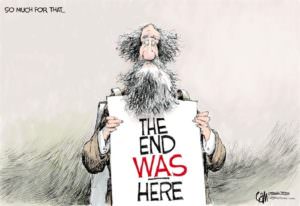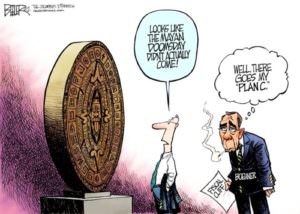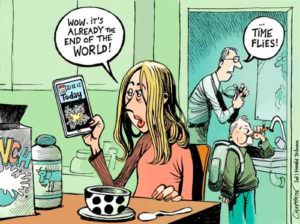Still Here? Happy New Bak’tun
Assuming we're all still here: What is it that humans find so compelling about impending oblivion?If you’re reading this, the Maya were wrong. Rather, they would have been wrong if they’d actually predicted the end of the world, which scholars are pretty sure they didn’t.
On the other hand, if there’s nobody around to thumb through the morning newspaper — if, indeed, there are no more scholars, newspapers, mornings or thumbs — then I guess it was a poor decision to spend Earth’s final day in my office. I’d have regrets, except I’m pretty sure that no more world means no more second-guessing.
Assuming we’re all still here: What is it that humans find so compelling about impending oblivion?
We go out of our way to look for the most obscure and cryptic clues that The End is nigh. This month’s scare — and many people, apparently, did convince themselves to be scared — is based on inscriptions carved into two Mayan ruins in Guatemala.
The Maya were obsessed with time, which they saw as moving in vast cycles. They developed a sophisticated and accurate calendar, and the inscriptions indicate they calculated that a major time cycle — and thus, some people have inferred, the world — would end on Dec. 21, 2012. In the world of doomsday anticipation, there’s simply no better source of information than an ancient soothsayer. Anything written in hieroglyphics pretty much has to be true.
But according to experts, the inscriptions in question had nothing to do with cosmic fate and everything to do with local politics. David Stuart, director of the Mesoamerica Center at the University of Texas — and discoverer of one of the two Dec. 21 references — has explained that the date represents the 13th turn of a long cycle known as a bak’tun. In 696 A.D., when the hieroglyphs were carved, the ruler Yuknoom Yich’aak K’ahk’ — standard pronunciation — was trying to enhance his power and legitimacy by associating his reign with an important turning of time’s vast wheel. All that happens on the appointed date is that the next cycle begins.
Happy New Bak’tun, everybody.
For the Last Days crowd, however, this was mere fine print. While present-day descendants of the Maya were unconcerned — “The world will not end,” priest Alfonso Ek told USA Today — there was genuine panic in isolated parts of the non-Maya world.
In Russia, there was so much hubbub over the Dec. 21 “prophecy” that a government minister felt compelled to announce that the planet was in no imminent peril. In some remote cities there was reportedly a run on supplies such as candles and dried foods.
“I don’t believe in the end of the world,” Prime Minister Dmitry Medvedev told Voice of Russia radio. “At least, not this year.”
There was reportedly a bit of panic buying in parts of China, apparently sparked by the popularity there of the Hollywood movie “2012” — a what-if blockbuster starring John Cusack that imagines all manner of earthquakes, volcanic eruptions, floods and other calamities. Supposedly, it all has to do with neutrinos from a solar flare that somehow heat up the Earth’s core.
Poor Danny Glover plays the president; he dies when a “mega-tsunami” sends an aircraft carrier crashing into the White House. So really, President Obama, the “fiscal cliff” problem could be much, much worse.
For world-enders of a New Age bent, much of the focus was on the village of Bugarach in the French Pyrenees. It happens that a famous local mountain — the Pic de Bugarach — is flat-topped, like the Devil’s Tower in Wyoming, which was the setting for Stephen Spielberg’s alien-encounter classic “Close Encounters of the Third Kind.”
Naturellement, some New Agers see Bugarach as another likely landing spot for extraterrestrials. And what better day for them to arrive than Dec. 21, 2012? The mayor of Bugarach feared such an invasion of free spirits wanting to be beamed up that he declared the whole mountain off-limits and dispatched police to enforce his edict.
This is the point at which I should quote some eminent psychologist who explains why Armageddon is such an enduring fantasy — why, to some people, the prospect of sudden and utter doom seems almost comforting. But I think my own theory is as good as any other: boredom. For most people, one day is pretty much like the next. What if something really big happened? What if I were there to see it? How awesome would that be?
You’re still with me, right? Hello? Anybody out there?
Eugene Robinson’s e-mail address is eugenerobinson(at)washpost.com.
© 2012, Washington Post Writers Group
Your support matters…Independent journalism is under threat and overshadowed by heavily funded mainstream media.
You can help level the playing field. Become a member.
Your tax-deductible contribution keeps us digging beneath the headlines to give you thought-provoking, investigative reporting and analysis that unearths what's really happening- without compromise.
Give today to support our courageous, independent journalists.






You need to be a supporter to comment.
There are currently no responses to this article.
Be the first to respond.